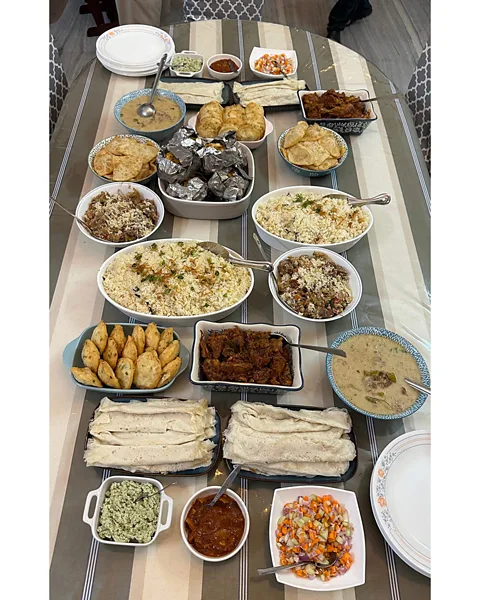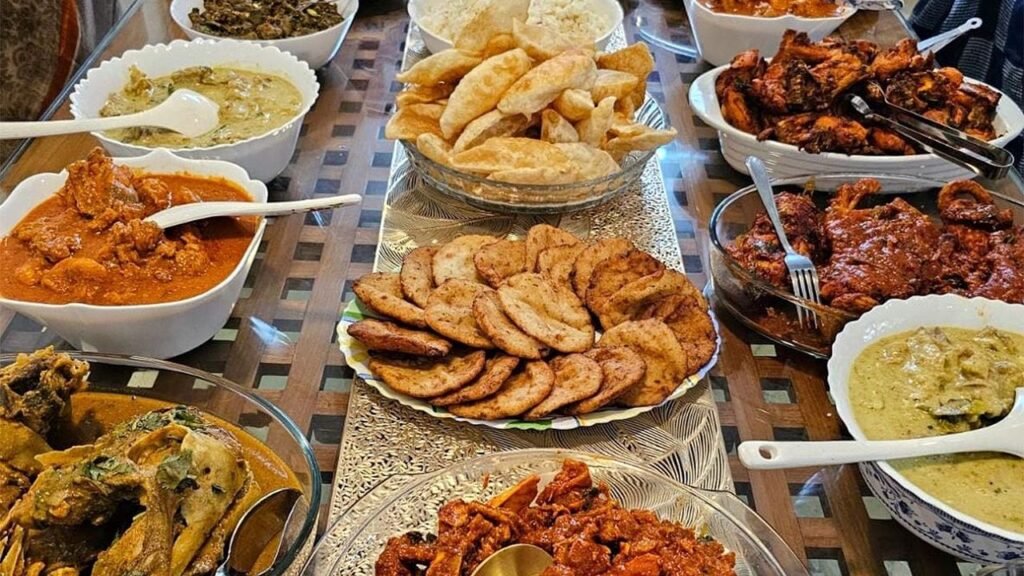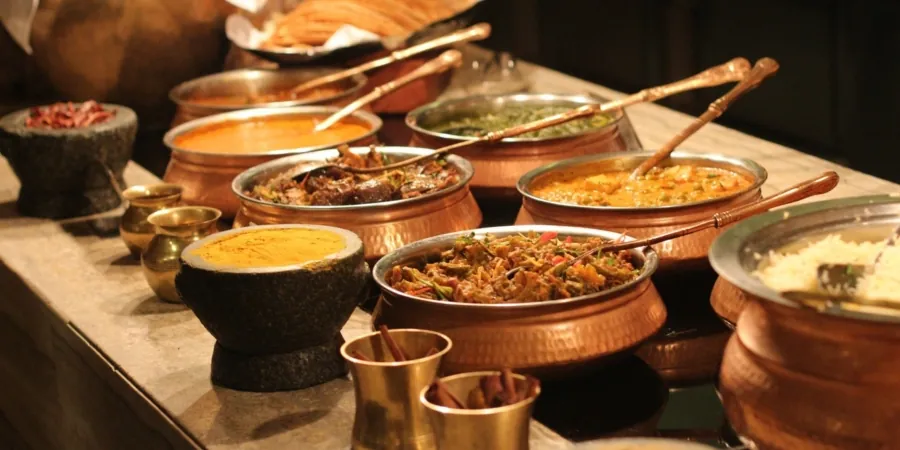For more than 700 years, a unique culinary tradition has flourished in southern India. In this ritual, newly married grooms are treated to a grand feast prepared by their mothers-in-law. Known as Puyyappla Perukkal, this ancient Indian wedding feast tradition continues in the coastal city of Thalassery, Kerala. It beautifully blends hospitality, devotion, and heritage into an unforgettable celebration.
India Wedding Feast Tradition: A 40-Day Culinary Celebration
Thalassery, once a key trading port on India’s spice coast, is famous for its aromatic cardamom, pepper, and cloves. Over centuries, this seaside city absorbed influences from Arab, Persian, Dutch, and British traders, creating one of India’s richest food cultures. Among its many culinary treasures, the Puyyappla Perukkal stands apart for its warmth and endurance.

The name translates to “nurturing the son-in-law”, and the ritual lives up to that meaning. For 40 days, the groom stays in his bride’s family home as a guest of honour, enjoying up to 100 dishes — many never repeated — prepared under the watchful care of his new mother-in-law and other female relatives.
The roots of this practice trace back to Kerala’s ancient Marumakkathayam matrilineal system, which granted inheritance rights to women. Over time, it evolved into a gesture of generosity and respect for the groom. The feast became a way to welcome him into the family with food, laughter, and warm hospitality.
Morning Meals in the India Wedding Feast Tradition
The celebration begins the very next day after the wedding. At dawn, the groom is served freshly made bread sizzling in ghee with pazham vatti (banana fritters) and boiled eggs. Breakfast soon follows with pathiri (rice flatbread), ari rotti, or ney pathiri — ghee-fried bread paired with aromatic lamb curry.
As local chef Rubeena Kalathiyath explains, “It’s not just about serving food — it’s about preserving our family’s recipes and memories.” Rubeena runs The Heritage 1866 homestay in Thalassery. She still prepares most of these dishes by hand using homemade garam masala. Her age-old techniques were passed down from her grandmother.
A Day of Endless Dishes in the India Wedding Feast Tradition
After breakfast, the groom departs for his home and returns in the evening to an even more elaborate spread. The dinner table often includes crispy lentil vadas, unnakaya (sweet plantain rolls stuffed with coconut and cardamom), and petti pathal (crispy chicken patties).

Lunches and dinners feature hearty staples such as aleesa (a wheat and chicken stew with coconut milk), mutton biryani, ghee rice, moodi pathiri (layered rice bread), and mutta mala (golden egg yolk threads in syrup). The diversity of flavours showcases the creativity and depth of Mappila Muslim cuisine, a culinary tradition that evolved from centuries of trade and cross-cultural exchange.
By the second week, chicken and mutton dishes dominate, each cooked differently — roasted, stewed, or grilled — ensuring the groom never tastes the same meal twice. “The items are too many to name,” Rubeena laughs, “but every dish is made with care and intention.”
Rituals of Respect and Reciprocity
Beyond the food, the Puyyappla Perukkal feast includes several playful rituals that reflect respect and reciprocity within families. One of these is the meen panam, or “fish money,” in which the groom offers a token amount to his mother-in-law so she can buy fish. It’s a symbolic act — and a way to show appreciation for the effort she puts into his meals.
Another custom, chaaya paisa, requires a small payment for each pot of tea brewed. This practice reinforces the value of gratitude, even in daily routines.

Local homemaker Khadeeja TC, who has hosted such feasts for her sons-in-law, recalls: “If the food wasn’t perfect, the groom would jokingly leave the house in protest. Then the uncles would coax him back with laughter. It was all in good spirit — a way of showing affection.”
A Tradition Evolving with Time
While the India wedding feast tradition remains a source of pride, modern life has changed how it’s practiced. With many families now living in cities or abroad, fewer households can devote 40 full days to the ritual. However, the spirit lives on — many families now condense the event into a single day, serving 40 symbolic dishes in one grand sitting.
Culinary instructor Zafira Amin from Thalassery notes, “Even if the full feast isn’t possible today, we still honour the essence — the sharing of love through food.” The condensed celebration reflects both modern convenience and timeless devotion. India wedding feast tradition.
Experiencing the Feast as a Traveller
Although traditional Mappila weddings are private family affairs, travellers can still experience these legendary flavours in Kerala and beyond. At The Heritage 1866, guests can sample classic dishes like aleesa, unnakaya, and biryani prepared with the same techniques used for generations.
Across Kerala, restaurants such as Paragon (in Kozhikode, Kochi, and Thiruvananthapuram), Moplah’s in Bengaluru, and Malabar Junction in London serve authentic Mappila cuisine to an international audience.

Food enthusiasts can also attend interactive workshops with chef Abida Rasheed in Kozhikode, a well-known ambassador of Malabar Muslim cooking. For those who wish to bring the taste of Thalassery home, the classic cookbook Malabar Muslim Cookery by Ummi Abdulla offers treasured recipes that preserve these traditions for future generations. India wedding feast tradition.
Preserving Faith, Family, and Flavour
Even after the 40 days pass, the memories of Puyyappla Perukkal remain as enduring as the bonds it celebrates. Every dish carries the essence of family, respect, and faith — a reminder that food in India is more than sustenance; it’s a language of love.
This timeless India wedding feast tradition continues to unite generations, blending ancient customs with modern life. Whether savoured in a Thalassery kitchen or at a Kerala restaurant, it reflects the heart of India. Each meal tells a story. Every flavour carries a rich legacy.




